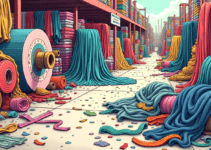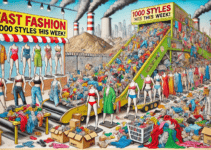The fashion assiduity is one of the largest global contributors to environmental declination, producing an estimated 92 million tons of waste each time. whirlwind fashion has accelerated the rate at which apparel is formed, devoured, and discarded, creating unsustainable pressure on natural coffers and waste operation systems. still, the conception of a indirect fashion frugality offers a encouraging volition, aiming to revise how fashion is aimed, produced, exercised, and reused. Let’s explore what a indirect fashion frugality might look like, its gut principles, and how it could reshape the fashion geography.

Gathering the indirect Fashion Economy
A indirect fashion frugality revolves around intending out waste and toxin, keeping accoutrements in use, and regenerating natural systems. Unlike the traditional direct model of “ take- make- dispose, ” a indirect frugality focuses on life, recyclability, and sustainability. It prioritizes intending productions for extended use, employing renewable coffers, and icing that accoutrements can be reused, repurposed, or biodegraded at the end of their lifecycle.
This paradigm measure requires systemic changes across the fashion value chain — from project and manufacturing to consumption and discarding. But what exactly would this look like in practice?
Crucial rudiments of a indirect Fashion Economy
Sustainable Design Practices
In a indirect fashion frugality, the project stage plays a pivotal part. Contrivers would prioritize continuity, versatility, and order. Clothes would be made utilizing high- quality accoutrements that can repel wear and tear and gash, reducing the want for constant reserves. project would also call how garments can be dismembered, making recycling easier.
For illustration, modular apparel designs could have guests to blend and match factors, dragging a single garment’s mileage. Accoutrements like organic cotton, recycled polyester, or ingeniousbio-based fabrics would come assiduity norms.
Resource effectiveness in Manufacturing
A indirect fashion frugality would punctuate utilizing renewable dynamism and minimizing resource waste during product. Advanced technologies similar as 3D printing and AI- driven optimization could reduce redundant fabric operation, while arid dyeing ways andeco-friendly chemicals would reduce environmental detriment.
Brands would
Also reference raw accoutrements responsibly, utilizing recycled filaments and finessing environmentally disastrous practices like inordinate water consumption or deforestation.
Closed- Loop Systems
A foundation of the indirect frugality is the unrestricted- circle system, where productions and accoutrements are continuously reused. For fashion, this means garments would be aimed to be reclaimed or upcycled at the end of their lifecycle. Consumers could return old clothes to brands for recycling or trade them in for store credits.
Companies like Patagonia and Eileen Fisher are formerly introducing take- back programs, establishing how old clothes can be given away new life. This path reduces tip waste and decreases the demand for virgin accoutrements .
Secondary and Resale requests
The resale request would thrive in a indirect frugality, encouraging consumers to viewpre-loved apparel as a precious resource preferably than waste. Platforms like ThredUp, Poshmark, and Depop are formerly growing in fashionability, making secondary shopping popular and charming.
Luxury brands could also grasp resale, as discerned with Gucci’s cooperation with The RealReal, icing that high- end fashion stays in rotation longer.
Reimbursement and Subscription Services
Reimbursement fashion services like Rent the Runway and Nuuly align impeccably with the indirect frugality morality. These platforms have consumers to rent clothes for a special period, reducing the want for one- time purchases.
Subscription models could also come popular, offering guests a swirling wardrobe while minimizing environmental jolt. By participating apparel preferably than retaining it outright, consumers can enjoy variety without contributing to overproduction.
Biodegradable and Regenerative fabrics
In a indirect frugality,non-biodegradable fabrics like polyester would be phased out in indulgence of biodegradable options. Brands could inoculate in regenerative fabrics made from accoutrements like algae, hemp, or indeed agrarian waste.
These fabrics not only break up down constitutionally at the end of their lifecycle but can also be composted to enrich soil health, creating a regenerative circle that benefits the terrain.
Consumer Instruction and Behavioral Shifts
For a indirect fashion frugality to deliver, consumer geste must revise. Education would play a vital part in encouraging individualities to value quality over volume, form clothes rather of discarding them, and make environmentally conscious copping opinions.
Brands could give translucency about their sustainability sweats, empowering consumers to make informed elections. enterprise like apparel care attendants or shops on repairing garments could farther nurture a cultivation of responsibility.
Expostulations to Beat
Transitioning to a indirect fashion frugality is no fragile trick. It requires collaboration among governments, brands, and consumers to beat significant expostulations
Structure for Recycling and Upcycling
Recycling cloth waste on a voluminous scale is presently limited by technological and logistical walls. numerous garments are made from amalgamated fabrics, which are delicate to disassociate for recycling.
Profitable Viability
Enforcing indirect practices can be expensive for brands, especially lower companies. Governments may need to incentivize sustainability through subventions or duty breaks to encourage wide relinquishment.
Consumer Mindset
Changing consumer fashions takes time. numerous people are oriented to whirlwind fashion’s low prices and luxury, making the transition to further sustainable consumption patterns a challenge.
The Future of indirect Fashion
The transition to a indirect fashion frugality represents a bold step toward a further sustainable future. By reimagining the fashion lifecycle, we can significantly reduce waste, conserve coffers, and alleviate environmental detriment.
While the path forth is n’t without its expostulations, the advantages of indirect fashion far overweigh the obstacles. With ingenious results, cooperative sweats, and a participated devotion to sustainability, the fashion assiduity can come a manpower for good — both for the earth and for the people who inhabit it.
The question remains Are we ready to grasp this transformative unreality? The time to portray is now.


